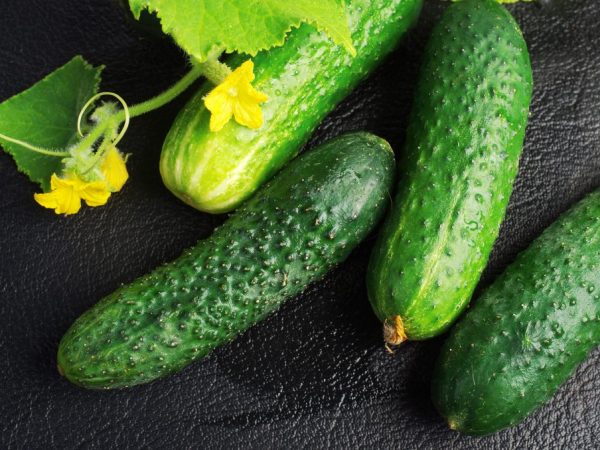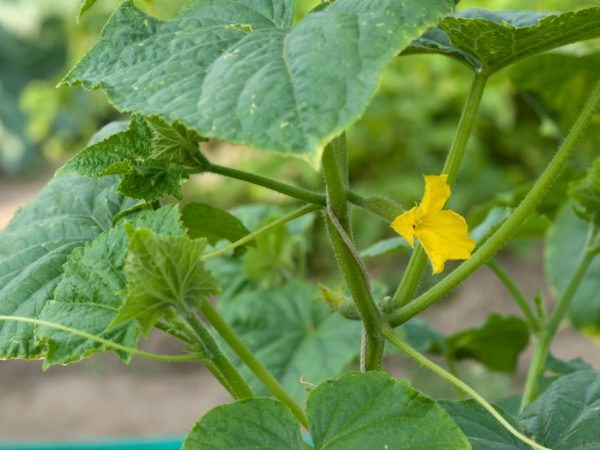Characteristics of Cedric cucumbers
Cucumber variety Cedric occupies one of the leading positions among fellow tribesmen. The variety quickly became popular. Summer residents often choose it for planting in greenhouses, which indicates its quality.

Characteristics of Cedric cucumbers
Characteristics of the variety
The Dutch variety is produced by the world famous company Enza Zaden. It is referred to as early maturing. Ripening occurs after 40-45 days. It is suitable for double seeding in heated greenhouses due to its short growing season.
Cedric f1 is a self-pollinating (parthenocarpic) variety. Its yield is about 15 kg per 1 sq. m., which allows it to be used in industrial cultivation.
The variety has proven itself well in stressful situations, does not throw off the ovary with temperature changes, continues to grow fruits.
Description of the bush
The bush is indeterminate, the central stem has unlimited growth. The number of lateral stems is average. Has a strong and powerful root system. Leaves are deep green in color, small in size. The pubescence of the stems is average. Up to 5 cucumbers are tied in knots.
Description of the fetus
Cedric f1 fruits have an elongated cylindrical shape, even. No ribbing, medium tubercles, short white spines are present. Cucumbers are green. The texture of the pulp is dense, the seeds are small. The average weight of cucumbers is 105-110 g, length is 10-14 cm. It is possible to harvest gherkins 5-7 cm long. Fruits are used for fresh salads, preservation and pickles.
Care
When planting this variety, you must take into account the peculiarities of the development of the bush. According to the description, it has an indeterminate type and a powerful root system, therefore, each bush needs to be provided with sufficient space for development. When planting seedlings, the prepared pit should have a diameter of about 40 cm.
Fertilizers and compost are introduced into it, which will provide a full nutrition of the bush for the entire growing season. For 1 sq. m it is permissible to plant 2-3 plants, the distance between the rows should be at least 50 cm.
Garter
Cedric is a hybrid of a cucumber intended for cultivation in greenhouses, which affects the characteristics of its care. Cedric f1 requires garter and trellis growing. The best option would be a vertical garter:
- a cord (fabric strip) is attached to the frame of the greenhouse;
- dipped to each individual plant;
- tied to the stem under the third leaf or attached to the ground with a metal bracket;
- let the cucumbers trudge up.
This method of cultivation makes it easier to care for the bushes and creates favorable conditions for growth.
To increase the fruiting of greenhouse varieties, the blinding technique is used.
How to conduct

This variety needs a garter
It is carried out as follows:
- remove all stepchildren and ovaries to the level of 6 pairs of leaves;
- the plants form into one central stem, cutting off the lateral lashes, leaving only the places where the ovary is formed;
- brought to the upper trellis in greenhouses and fixed;
- when shoots grow in the nodes and there are about 5 leaves on them, pinch the top of the central stem;
- as it dries, the lower leaves are removed.
Fertilizers
The Cedric F1 variety requires regular feeding due to its intensive growth and fruiting. Can be used:
- complex mineral;
- organic;
- folk recipes.
They will all be effective when used correctly and kept in dosage.
When growing cucumbers, it is important to remember to water regularly. A sufficient amount of moisture is necessary for the full development of the plant, and its lack or excess can significantly harm the bushes.
Diseases
Cedric is a highly resistant to cladosporiosis variety, but it is more susceptible to other diseases. May be amazed:
- powdery mildew;
- parasporosis;
- fusarium;
- cucumber mosaic.
All these diseases most often affect weak plants, especially in conditions of non-compliance with agricultural technology.
Prophylaxis
In order for the bushes to remain healthy and not undergo diseases, you need:
- monitor watering;
- apply fertilizers in sufficient quantities;
- avoid overheating or hypothermia;
- avoid thickening;
- process for prophylaxis with Gaupsin or Trichodermin.
Pests
Infection of cucumbers with such pests as aphids, whiteflies, spider mites is possible. For prevention, you can use a folk recipe and process the bushes with onion peel infusion. Onions contain phytoncides, which repel pests well.
To prepare the infusion, 1 glass of husk is poured with 2 liters of boiling water, insisted for 2 days. The finished infusion is filtered and diluted in 10 liters of water. The bushes are sprayed with infusion every 10 days.
Treatment
If, nevertheless, it was not possible to protect the plants from pests, in order to solve this problem, it will be enough to treat the cucumbers with a high-quality insecticide. It can be Aktellik, Aktara, Confidor. Or bioinsecticides such as Bioreid, Actarophyte.
Conclusion
A high yield of cucumbers depends not only on how carefully the care was carried out, but also on the quality of the seeds and the characteristics of the selected variety. Correctly selected varietal cucumbers will delight you with growth, unpretentiousness and productivity.


